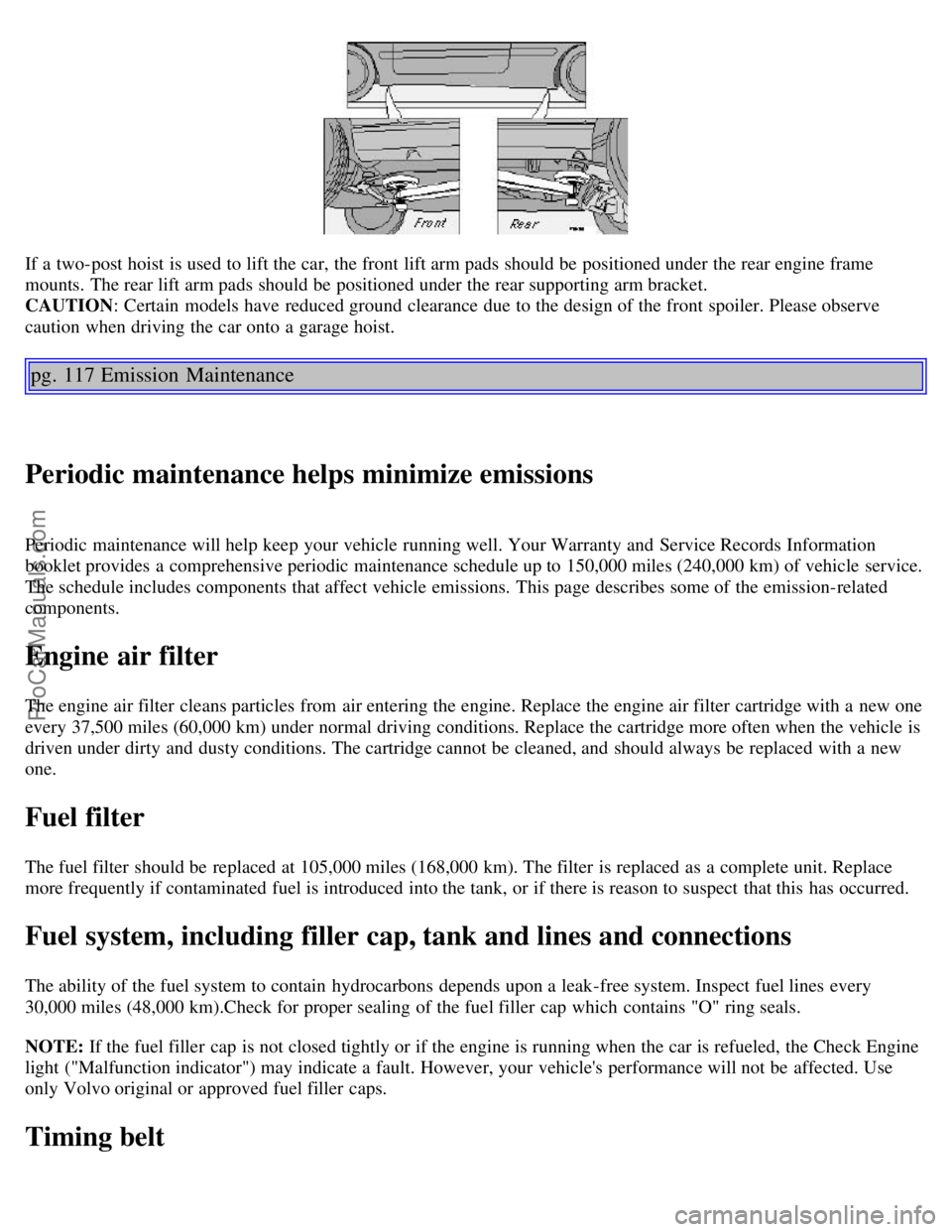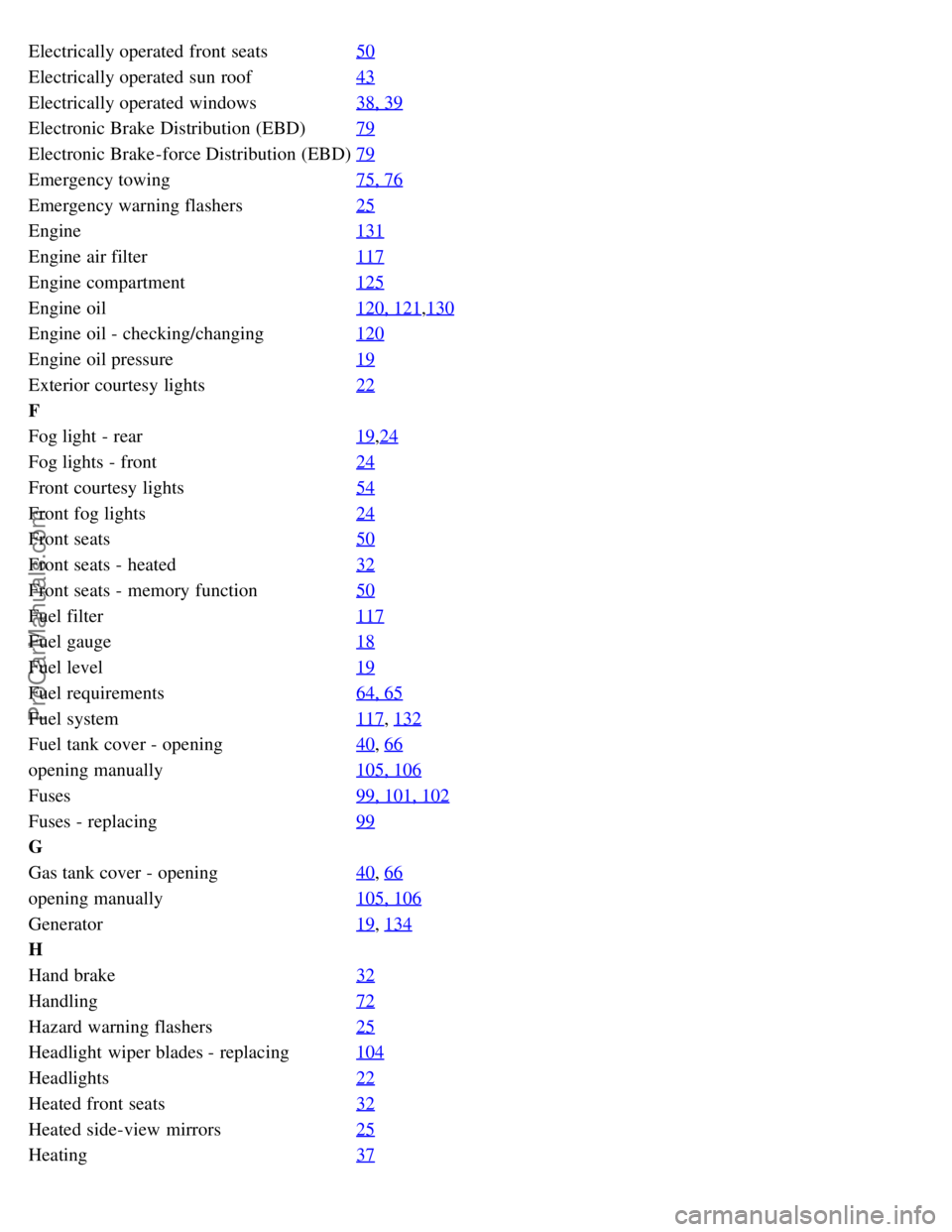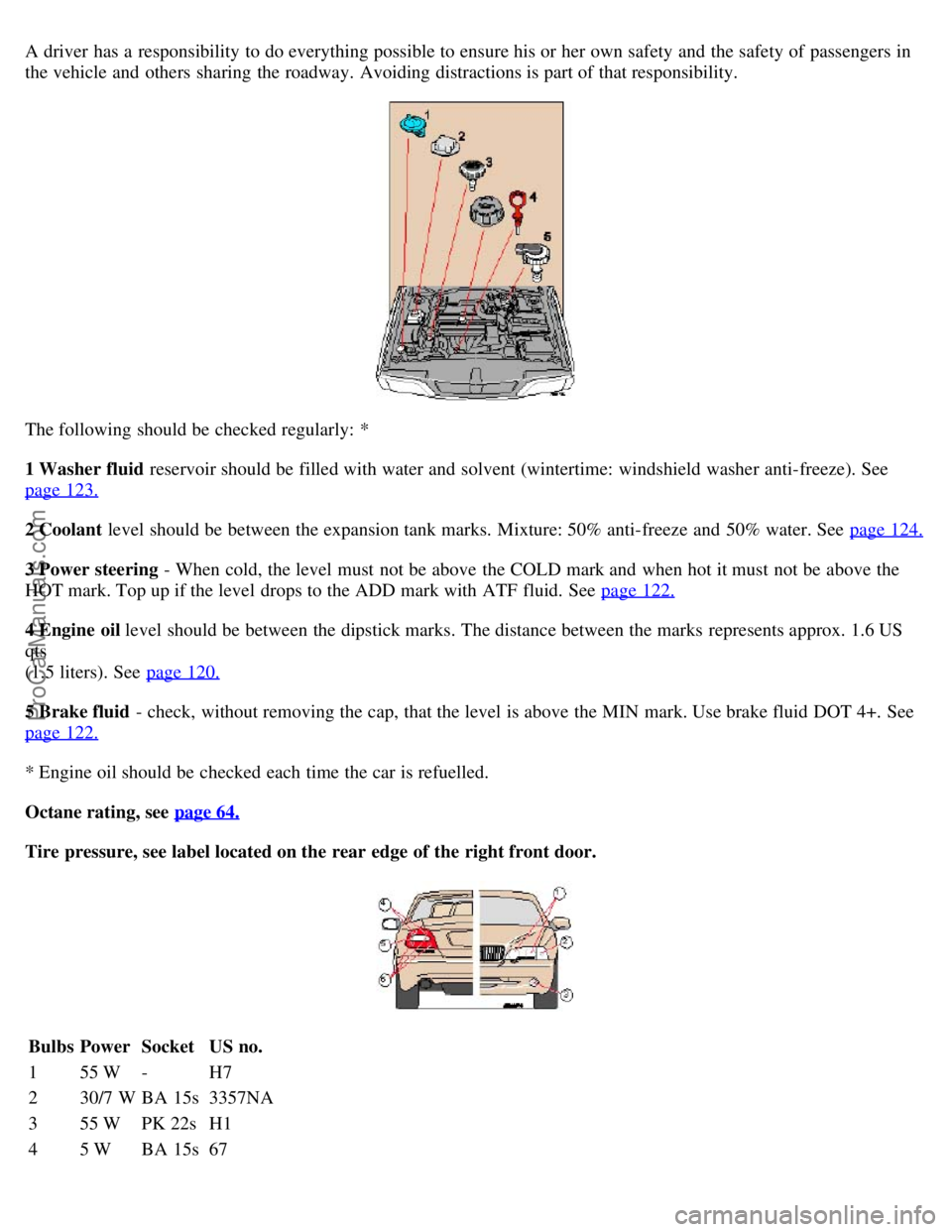check engine VOLVO C70 2002 User Guide
[x] Cancel search | Manufacturer: VOLVO, Model Year: 2002, Model line: C70, Model: VOLVO C70 2002Pages: 99, PDF Size: 2.56 MB
Page 58 of 99

2 0 0 2
VOLVO
C70 Coupe & Convertible
Chapter 7 - Car care
pg. 107 Car care
Page
Paint touch-up 108
Washing110
Cleaning the convertible top, Polishing and waxing111
Cleaning the upholstery112
pg. 108 Paint touch up
Paint touch-up
Paint damage requires immediate attention to avoid rusting. Make it a habit to check the finish regularly when washing
the car for instance. Touchup if necessary.
Paint repairs require special equipment and skill. Contact your Volvo retailer for any extensive damage.
Minor scratches can be repaired by using Volvo touchup paint.
NOTE: When ordering touchup paint from your Volvo retailer, use the paint code indicated on the model plate. The
plate is located in the engine compartment, on the inside of the left front fender.
Minor stone chips and scratches
Material:
Primer can
ProCarManuals.com
Page 66 of 99

If a two-post hoist is used to lift the car, the front lift arm pads should be positioned under the rear engine frame
mounts. The rear lift arm pads should be positioned under the rear supporting arm bracket.
CAUTION: Certain models have reduced ground clearance due to the design of the front spoiler. Please observe
caution when driving the car onto a garage hoist.
pg. 117 Emission Maintenance
Periodic maintenance helps minimize emissions
Periodic maintenance will help keep your vehicle running well. Your Warranty and Service Records Information
booklet provides a comprehensive periodic maintenance schedule up to 150,000 miles (240,000 km) of vehicle service.
The schedule includes components that affect vehicle emissions. This page describes some of the emission-related
components.
Engine air filter
The engine air filter cleans particles from air entering the engine. Replace the engine air filter cartridge with a new one
every 37,500 miles (60,000 km) under normal driving conditions. Replace the cartridge more often when the vehicle is
driven under dirty and dusty conditions. The cartridge cannot be cleaned, and should always be replaced with a new
one.
Fuel filter
The fuel filter should be replaced at 105,000 miles (168,000 km). The filter is replaced as a complete unit. Replace
more frequently if contaminated fuel is introduced into the tank, or if there is reason to suspect that this has occurred.
Fuel system, including filler cap, tank and lines and connections
The ability of the fuel system to contain hydrocarbons depends upon a leak-free system. Inspect fuel lines every
30,000 miles (48,000 km).Check for proper sealing of the fuel filler cap which contains "O" ring seals.
NOTE: If the fuel filler cap is not closed tightly or if the engine is running when the car is refueled, the Check Engine
light ("Malfunction indicator") may indicate a fault. However, your vehicle's performance will not be affected. Use
only Volvo original or approved fuel filler caps.
Timing belt
ProCarManuals.com
Page 67 of 99

For proper functioning of the vehicle and its emission control systems, the timing belt and belt tensioner must be
replaced every 105,000 miles (168,000 km). Engine damage will occur if the belt fails.
PCV system
(on turbocharged models)
The nipple in the intake manifold and the filter at the end of the PCV hose in the air cleaner should be inspected and
cleaned at 105,000 miles (168,000 km) and thereafter, again at 150,000 mile (240,000 km) intervals.
Spark plugs
The spark plugs should be replaced every 60,000 miles (96,000 km) under normal driving conditions. City driving or
fast highway driving may necessitate replacement sooner.
Under normal driving conditions, spark plugs require no maintenance between replacement intervals. When installing
new plugs, be sure to use the right type and to tighten them correctly. When changing the plugs, clean the terminals
and rubber seals. Also check that the suppressor connectors are in good condition. Cracked or damaged connectors
should be replaced.
pg. 118 Fuel/emissions systems
Fuel system
The fuel system is allelectronic and is microprocessorcontrolled. It can continually compensate for variation in engine
load, speed and temperature to give the best economy and power. A mass air flow sensor measures the inducted air. In
this way the system can make instantaneous adjustments for changes in air temperature or density, thus always
assuring the best economy with the lowest possible exhaust emissions.
Heated oxygen sensor(s)
This is an emission control system designed to reduce emissions and improve fuel economy. The heated oxygen sensor
monitors the composition of the exhaust gases leaving the engine. The exhaust gas analysis is fed into an electronic
module. This adjusts the airfuel ratio to provide optimum conditions for combustion and efficient reduction of the three
major pollutants (hydrocarbons, carbon monoxide and oxides of nitrogen (NOx) by a threeway catalytic converter.
Crankcase ventilation
Crankcase ventilation
The engine is provided with positive crankcase ventilation which prevents crankcase gases from being released into the
atmosphere. Instead, the crankcase gases are admitted to the intake manifold and cylinders.
ProCarManuals.com
Page 92 of 99

Electrically operated front seats50
Electrically operated sun roof43
Electrically operated windows38, 39
Electronic Brake Distribution (EBD)79
Electronic Brake-force Distribution (EBD)79
Emergency towing75, 76
Emergency warning flashers25
Engine131
Engine air filter117
Engine compartment125
Engine oil120, 121,130
Engine oil - checking/changing120
Engine oil pressure19
Exterior courtesy lights22
F
Fog light - rear19
,24
Fog lights - front24
Front courtesy lights54
Front fog lights24
Front seats50
Front seats - heated32
Front seats - memory function50
Fuel filter117
Fuel gauge18
Fuel level19
Fuel requirements64, 65
Fuel system117, 132
Fuel tank cover - opening40, 66
opening manually105, 106
Fuses99, 101, 102
Fuses - replacing99
G
Gas tank cover - opening40
, 66
opening manually105, 106
Generator19, 134
H
Hand brake32
Handling72
Hazard warning flashers25
Headlight wiper blades - replacing104
Headlights22
Heated front seats32
Heated side-view mirrors25
Heating37
ProCarManuals.com
Page 98 of 99

A driver has a responsibility to do everything possible to ensure his or her own safety and the safety of passengers in
the vehicle and others sharing the roadway. Avoiding distractions is part of that responsibility.
The following should be checked regularly: *
1 Washer fluid reservoir should be filled with water and solvent (wintertime: windshield washer anti-freeze). See
page 123.
2 Coolant level should be between the expansion tank marks. Mixture: 50% anti-freeze and 50% water. See page 124.
3 Power steering - When cold, the level must not be above the COLD mark and when hot it must not be above the
HOT mark. Top up if the level drops to the ADD mark with ATF fluid. See page 122.
4 Engine oil level should be between the dipstick marks. The distance between the marks represents approx. 1.6 US
qts
(1.5 liters). See page 120.
5 Brake fluid - check, without removing the cap, that the level is above the MIN mark. Use brake fluid DOT 4+. See
page 122.
* Engine oil should be checked each time the car is refuelled.
Octane rating, see page 64.
Tire pressure, see label located on the rear edge of the right front door.
Bulbs Power Socket US no.
1 55 W - H7
2 30/7 W BA 15s 3357NA
3 55 W PK 22s H1
4 5 W BA 15s 67
ProCarManuals.com